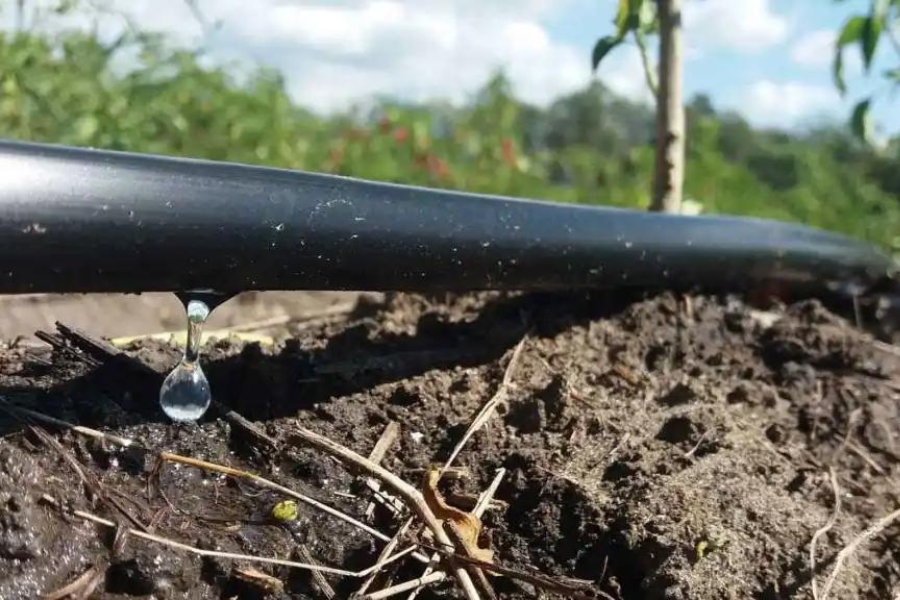Posted On: April 27, 2024
Posted By: KSNM DRIP

Drip irrigation revolutionizes farming by delivering water directly to plant roots, enhancing efficiency and crop health. This modern technique mitigates water wastage, offering a tailored solution for diverse terrains and crops. Understanding its benefits and limitations empowers farmers to optimize yields sustainably.
Drip irrigation is a type of controlled irrigation method where water is applied directly to the roots of plants in drops through drippers. Apply water slowly and directly to the plants there is no need to worry about wastage of water through evaporation and other factors. This irrigation method transfers the necessary nutrients exactly to the plants, minimizing loss and improving efficiency which can be seen at the time of harvest.
Drip irrigation is one of the modern irrigation methods and it has its limitations, within those limitations it is good. Some plants grow better with another type of irrigation method than drip irrigation. So, with a lot of considerations to take in one can say drip irrigation is good for the most and bad for some.
Different types of drip irrigation offer unique benefits and are suited for different applications, allowing for efficient and customized watering solutions. Here are the different types of drip irrigation for you to choose from that best suit your needs.
Surface drip irrigation delivers water directly to the soil surface through emitters or drip lines. This method is ideal for row crops, orchards, and vegetable gardens. It ensures efficient water use by targeting the root zone and reducing evaporation and runoff.
Sub-surface drip irrigation delivers water below the soil surface through buried drip lines. It's commonly used for perennial crops like trees and vineyards. SDI minimizes water loss from evaporation and surface runoff, promoting healthier root development and higher yields.
Inline drip irrigation integrates emitters into the drip line, providing consistent water flow along its entire length. This type is suitable for large-scale farming and landscapes, offering uniform water distribution and easy installation.
Micro-spray or micro-jet drip irrigation uses low-volume sprayers or jets to deliver water in a small area. It's popular in greenhouses, nurseries, and flower beds, offering gentle watering for delicate plants and seedlings.
Drip tape is thin-walled tubing with emitters spaced at regular intervals. It's commonly used for row crops and vegetable gardens. Drip tape is cost-effective and easy to install, providing efficient water distribution directly to the plant roots.
Point source drip irrigation places individual emitters near each plant or tree. This method is ideal for home gardens and landscaped areas with diverse plantings. It allows for precise watering, tailored to the needs of each plant.
Potted plant drip irrigation is designed specifically for containers, delivering water directly to the potting mix. It's perfect for indoor plants, patio containers, and hanging baskets, ensuring plants receive consistent moisture without overwatering.
Significant Yield Increase: Drip irrigation can boost crop yields by up to 230%, ensuring farmers get more produce from their fields.
Water Efficiency: Compared to flood irrigation, drip irrigation saves up to 70% of water. This water conservation allows more land to be irrigated with the saved water, maximizing agricultural productivity.
Improved Crop Health and Growth: With consistent moisture and nutrient delivery, crops grown with drip irrigation are healthier, grow consistently, and mature faster. This leads to higher and faster returns on investment due to early maturity.
Enhanced Fertilizer Use Efficiency: Drip irrigation increases fertilizer use efficiency by 30%. This not only improves crop nutrition but also reduces the overall cost of fertilizers, inter-culturing, and labor.
Versatility in Terrain and Land Types: Drip irrigation systems are adaptable to various terrains including undulating, saline, waterlogged, sandy, and hilly lands. This allows even challenging landscapes to be brought under productive cultivation, expanding agricultural opportunities.
Drip irrigation stands out as a versatile and water-efficient irrigation solution suitable for a wide range of crops and terrains. With its ability to boost yields, conserve water, and enhance crop health, drip irrigation proves to be a valuable tool for modern agriculture, despite some challenges. Proper planning and maintenance can help maximize its benefits and contribute to sustainable farming practices.